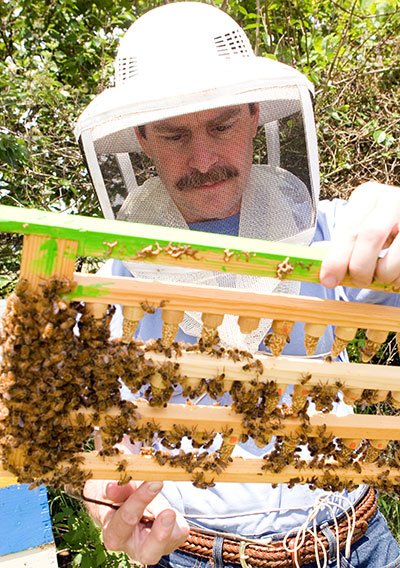By Susan A. Steeves
August 21, 2008
 |
A $4 million grant will enable Purdue's Greg Hunt and a multi-institutional research group to expand their studies on why honeybees are disappearing. Hunt, a bee geneticist, says it's likely a combination of pathogens, pesticides and parasites is causing the syndrome knows as colony collapse disorder. (Purdue Agricultural Communication photo/Alex Turco) |
WEST LAFAYETTE, Ind. -
combination of pathogens, pesticides and parasites may underlie such a massive disappearance of honeybees that agricultural production may be threatened, says a Purdue University researcher.
Greg Hunt, a Purdue apicultural researcher and geneticist, is collaborating with 19 scientists from around the country to launch an in-depth study of bees' behavior, lives, illnesses and deaths to define the syndrome known as colony collapse disorder (CCD). The investigators' goal is to find ways to restore bee colonies and keep them safe.
Hunt and his team are using genomics to investigate honeybee diseases and to indentify genes that make the insects resistant to a particularly harmful parasite and to pathogens. Other project collaborators will do genetic testing and observe bees in laboratories and in colonies as they try to discover what's causing losses of whole colonies.
"This project is about honeybee health because it is likely more than one factor is involved in CCD," Hunt said. "It's a mystery whether colony collapse is truly something new or whether it's a combination of factors."
Colony collapse disorder is not a disease, it's a syndrome, he said. A disease is caused by a known pathogen while a syndrome is a set of symptoms. At least 24 states, Canada and most European countries have reported cases of CCD; Indiana is not among them.
"There could be a lot of things that make bees forget where they live and not return to the hive," Hunt said. "They could have any number of diseases that might potentially cause these types of symptoms. But in the experience of researchers and beekeepers looking at colony collapse disorder, it seems to be something new."
Bees carry pollen to flowering plants, including everything from wildflowers to the food we eat, so that plants are fertilized and can produce fruits and vegetables. Loss of honeybees could be devastating for many plants, especially food crops.
Hunt and his team at Purdue will develop diagnostic genetic tools to detect diseases and monitor honeybees. They will search for viral proteins and study at virus genomes. They also will study bee genomes to develop more breeding programs in which the pollinators are resistant to mites and pathogens.
Varroa mites play a large part in dwindling bee colonies because not only are the parasites weakening the bees, but they also transmit viruses to the bees. The already weak bees then succumb more easily to the viruses.
"Varroa mites are the worst problem in beekeeping worldwide in my opinion because it's so virulent," Hunt said.
In addition to Varroa mites, another contributor to the bees' disappearance is Nosema, a type of fungus that causes disease when bees ingest the Nosema spores, Hunt said.
What is now known as colony collapse disorder came to the forefront in summer 2006 and winter of 2006-2007 when high death rates of bee colonies suddenly occurred. Before the arrival of the mites in the 1980s, beekeepers expected to lose about 10 percent of their hives annually. Now some are losing as many as 90 percent.
The Apiary Inspectors of America report that last winter 35 percent of U.S. bee colonies were lost in the United States. Purdue lost 10 percent of its hives last year, which is about normal, Hunt said.
If high hive losses continue, it could be devastating to agriculture. Approximately 1.3 million beehives are needed every year just to pollinate the almond plants grown in California. It's estimated the number of beehives in the country is only a little more than 2 million.
Nineteen other researchers and their labs from 17 institutions are part of the collaboration. Keith Delaplane from the University of Georgia-Atlanta is the principal investigator. The institutions in addition to Purdue and the University of Georgia are: UCLA-Riverside; the Connecticut Agricultural Experiment Station; Cornell University; Kentucky State University; University of Maine; University of Massachusetts; Michigan State University; University of Minnesota; University of Nebraska-Lincoln; Pennsylvania State University; the University of Tennessee; The USDA Baton Rouge, La., Bee Laboratory; USDA Weslaco, Texas, Bee Laboratory; and Washington State University.
Writer: Susan A. Steeves, (765) 496-7481, ssteeves@purdue.edu
Source: Greg Hunt, (765) 494-6747, ghunt@purdue.edu
Ag Communications: (765) 494-2722;
Beth Forbes, forbes@purdue.edu